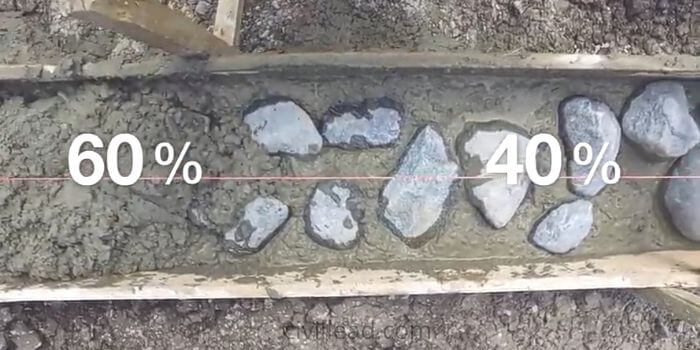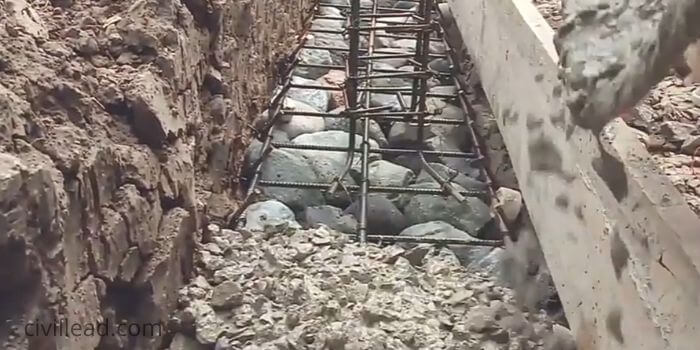Table of Contents
What is plum Concrete?
In mass concreting work, hard natural stones of size up to 300 mm or even big are used, such Concrete is known as plum concrete, and the stone used in this concrete is called plum.
Plum concrete is an economic adaptation for mass concreting. The application of plum concrete is suitable if the necessary thickness of PCC is more or unreasonable. It saves cost, provides economy and protects heat generation.
Usually, it is done to bypass using an excessive amount of cement without compromising its strength.
It is mainly used in mass concreting of foundations, dams, and other mass concrete works where the quantity of levelling courses may be extreme due to the strata’s steep slope.
It is prepared by the inclusion medium or large hard stone size of up to 300 mm.
Plums volume should not pass 30% – 40% of the total finished concrete volume. Plum concrete also refers to Cyclopean Concrete or Rubble concrete.
It should not be greater than one-third of the concrete mixer cross-section.
As per technical specification, plum concrete should be formed with a mixture of 40% large stones and 60% plain cement concrete.
The stone used for this Concrete should follow the ASTM standard, and the specification will be as per the concrete design.
Also, Read - Grade of Concrete and Their Uses
Purpose of Plum Concrete
Plum concrete is used to attain the required surface-level below the foundation and footing.
It is used to lessen the cost of PCC if the required thickness of PCC is large.
Primarily it is used in mass concreting work such as side slops, barrier, and gravity dams.
For instance, in the construction of a residential building, the small area under a footing is too steep, then it is preferable to use plum concrete.
Difference Between Plain Cement Concrete and Plum Concrete
Plain cement concrete or PCC is the most straightforward form of Concrete. It is produced by mixing primary ingredients such as cement, sand and aggregates.
While in plum concrete, instead of aggregates, medium and large stones are used as filler material instead of coarse aggregates.
So the main difference between PCC and plum Concrete is the boulders insertion in the concrete mix.
It serves as a filler material, lessening the quantity of coarse aggregates, which are generally expensive. Thus, it reduces the cost of PCC.
Also Read - What is Concrete Cover? - Clear Cover, Nominal Cover and Effective Cover
Plum Concrete Ratio

The Plum Concrete ratio should be 40/60, 40% plums (boulders), and 60% concrete (M10 or M15). Usually, the M15 concrete grade is used.
Plums beyond 160 mm and any reasonable size may be utilised in PCC work up to the maximum limit of 20% by concrete volume when specially allowed by the engineer-in-charge. The stones should be spread evenly and should not be denser than 150 mm from the surface.
Plum Concrete Calculation
As I mentioned above, plum concrete is primarily used for surface levelling. It should contain 40% boulders and 60% M10 or M20 concrete of its total volume.
For example
Suppose an area of 10 square meter and the thickness required for concrete is about 1000 mm, then.
Total Quantity of Plum Concrete = Area x Thickness
= 10 x 1
= 10 Cum.
Method – 1
Cement Concrete Quantity = 60% of total Volume = 10 x 60% = 6 cum.
Plums (boulders) Quantity = 40% of total Volume = 10 x 40% = 4 cum.
The above calculation will provide you with a plum concrete of 10 cum where concrete will utilise 6 cum and rubble stone 4 cum.
Note: It is challenging to estimate the quantity of rubble stone accurately as there is no fixed size and shape of rubble stones. Generally, we also consider the voids 20 to 40% while calculating the quantity.
Method – 2
The second method provides you near precise calculations by considering the weight density of concrete at 2400 kg/cu.m and the weight density of rubble stone at 2850 kg/cu.m
Plum concrete quantity = 10 cum
cement Concrete quantity = 6 cum x 2400 kg=14400 kg
Rubble Stone Quantity = 4 cum x 2850 kg = 11400 kg
All the above-estimated quantity require to be measured using a weighing machine and used subsequently.
Also, Read - Standard Room Sizes & Their Location In Residential Building
How to Prepare Plum Concrete?

There are two easy ways to prepare plum concrete. Either by adding the plum to the concrete mix during concrete mixing or spreading the plums over the cement concrete layer and then spreading another concrete layer.
Special attention is required while placing the plums in the concrete to prevent air traps. The usual making process is as follows:
Plums inspection
The boulders selected as plum should be strong, durable and free from dirt or clay. They should not be flaky. It is preferable to use the stone from the same rock from which aggregate. It should be washed and cleaned before using.
Plum Transportation
Firstly, the boulders needed for making plum concrete are carefully hand-picked. The boulders (plums) size should be up to 300mm.
The plum size is limited to nearby 1/3rd of the total volume. The plums can either be hand-picked or randomly picked by the labours and transported to the site.
Preparation of Surface
- Firstly, cleaning and levelling the surface are done by removing soft soil, affecting soil bearing capacity.
- After clearing and dressing the surface, water is sprinkled to keep the surface moist before placing the plum concrete.
- The sprinkling of water is done to ensure a proper bond between ground and concrete.
- An anti-termite compound is also sprayed, which is necessary for the building.
Plums and Concrete Placement
- Plums are laid over the ground at a small distance (not more than 150 mm from the surface) in layers then, concrete is poured into the crevices of each layer, which gradually fills the gapping between plums.
- After pouring concrete, again boulders are laid into the concrete, and the same process is repeated until the required surface level is achieved.
Curing
The curing of plum concrete is done up to 7 days after jute bags cover that entire concrete surface to keep it moist.
Also, Read - House Construction Cost Calculator Excel Sheet
Plum Concrete Specifications
- The plum should be trap, basalt, or any other locally available stone with the minimum crushing strength of 100 kg/cm2.
- The concrete used for plum concrete should be a nominal mix of M10 (1:3:6) and the aggregate used in concrete of maximum size 25 mm.
- The plum’s volume in concrete should not be more than 50% of the total volume.
- Each layer thickness should not greater than 900mm, and the division should not be less than 150 mm. For plum, you can also refer to IS 456:2000 clause 5.3.3.
- It is preferable to make up the total volume with plum and fill all the crevices (should not be less than 150 mm) with cement concrete.
- The water-cement ratio may be altered to have the concrete flow to fill all the crevices suitably at the site.
- The plums are laid in layers using cement concrete as mortar.
- Plum concrete should be kept wet for a minimum of seven days.
- The density of plum concrete is 2580 kg/m3.
Still, the stones should be spread uniformly in all the cases and should not be denser than 150 mm from the surface.
Plum Concrete Uses

- Primarily it is suitable to level the ground under the foundation, where the surface is uneven. Additionally, it is also convenient to level the ground with a steep slope.
- It is generally used to construct massive structures like gravity dams and bridges, but the plum size is restricted to 150 mm.
- It is appropriate for the construction of a surface bed of water channels.
- It is essentially used for the construction of the barriers of roads and railways bridges.
- It is appropriate for the construction of machine foundations where mass concrete is needed.
Also, Read
What is Slab Beam| Flat Beam| Hidden Beam| Concealed Beam?
Difference Between Nominal Mix and Design Mix Concrete.
Concrete Mix Ratio – Types, Proportioning of Concrete Mix and Methods
What is Workability of Concrete? – Factors affecting workability of Concrete.
Pre-stressed concrete – Definition, Methods, Advantages and Disadvantages
Difference Between Pre Tensioning and Post Tensioning